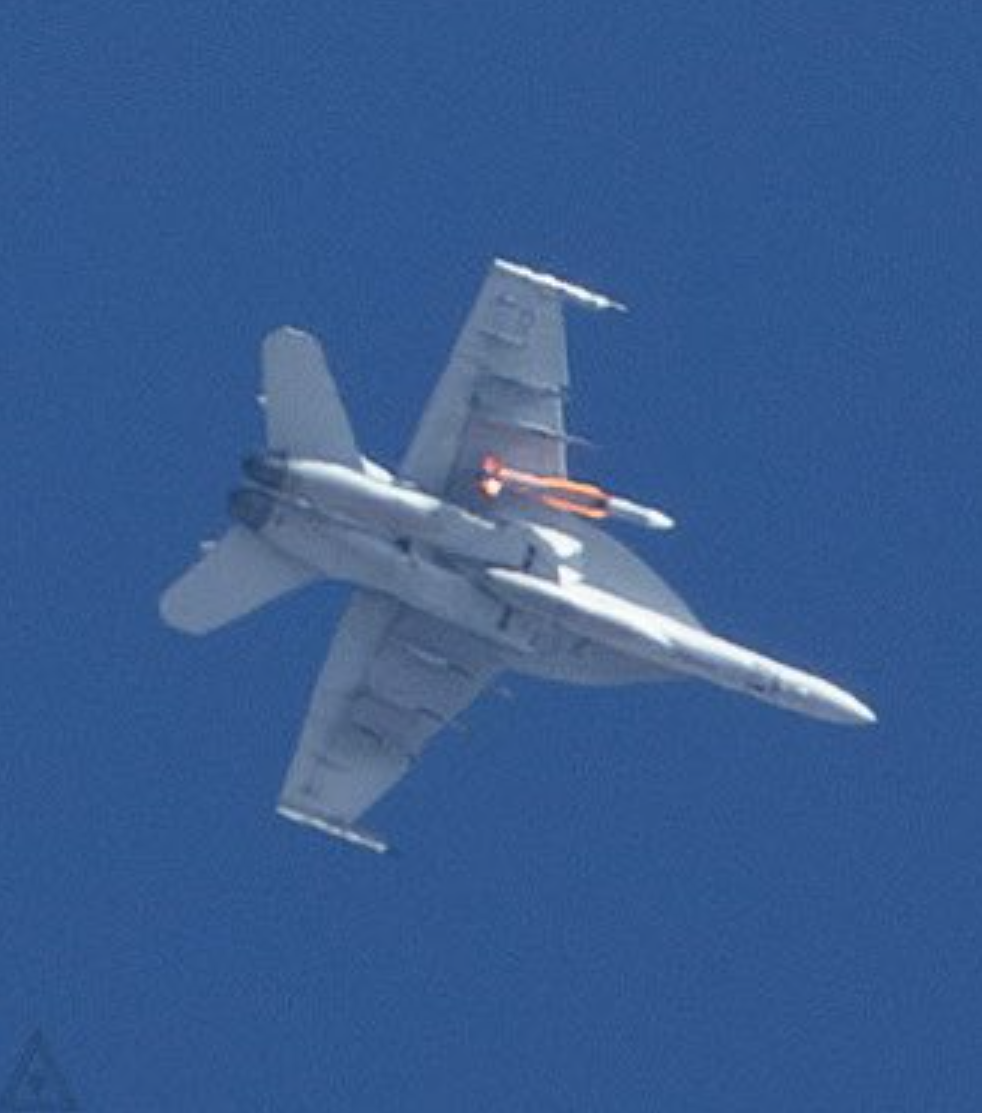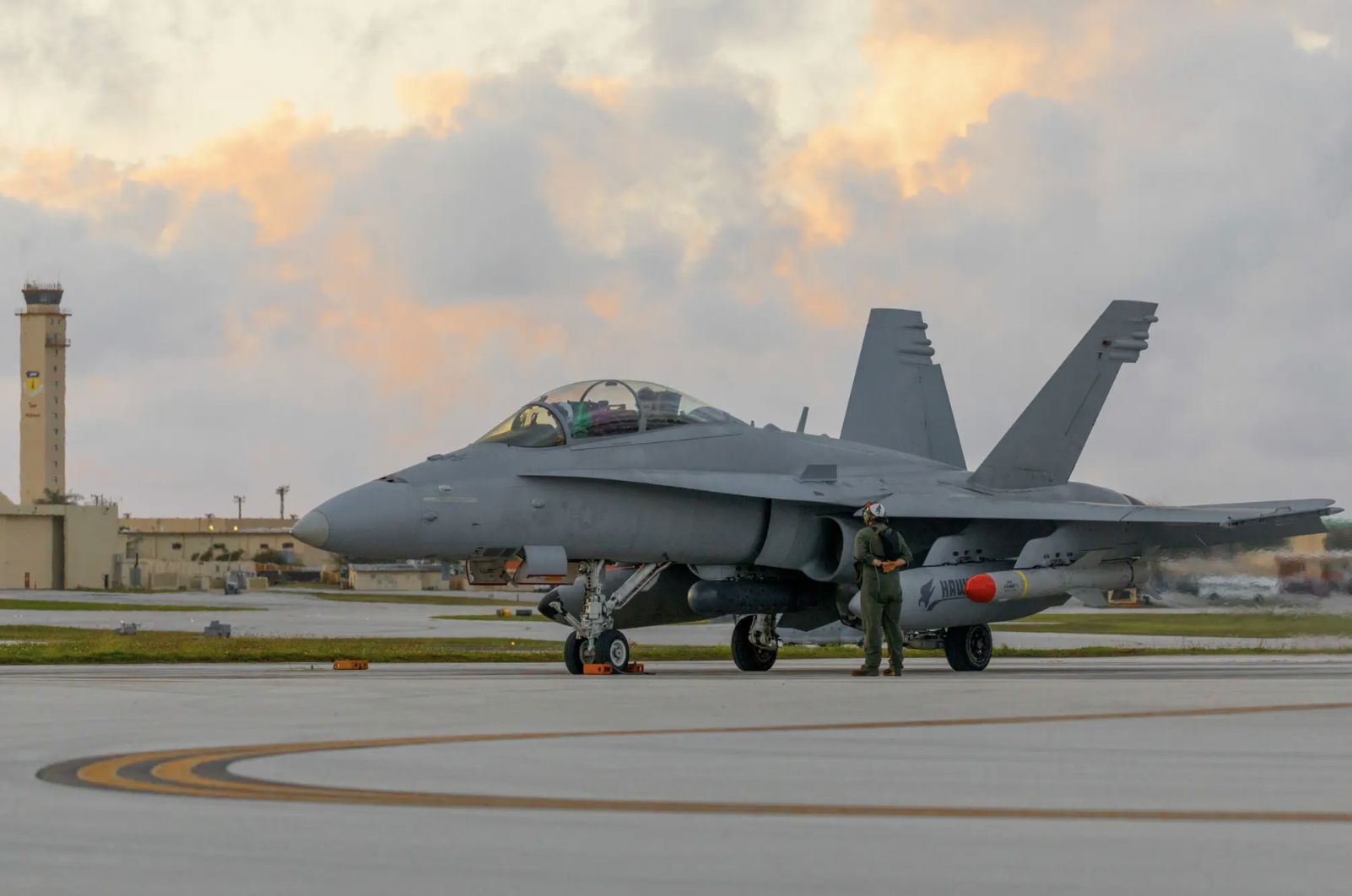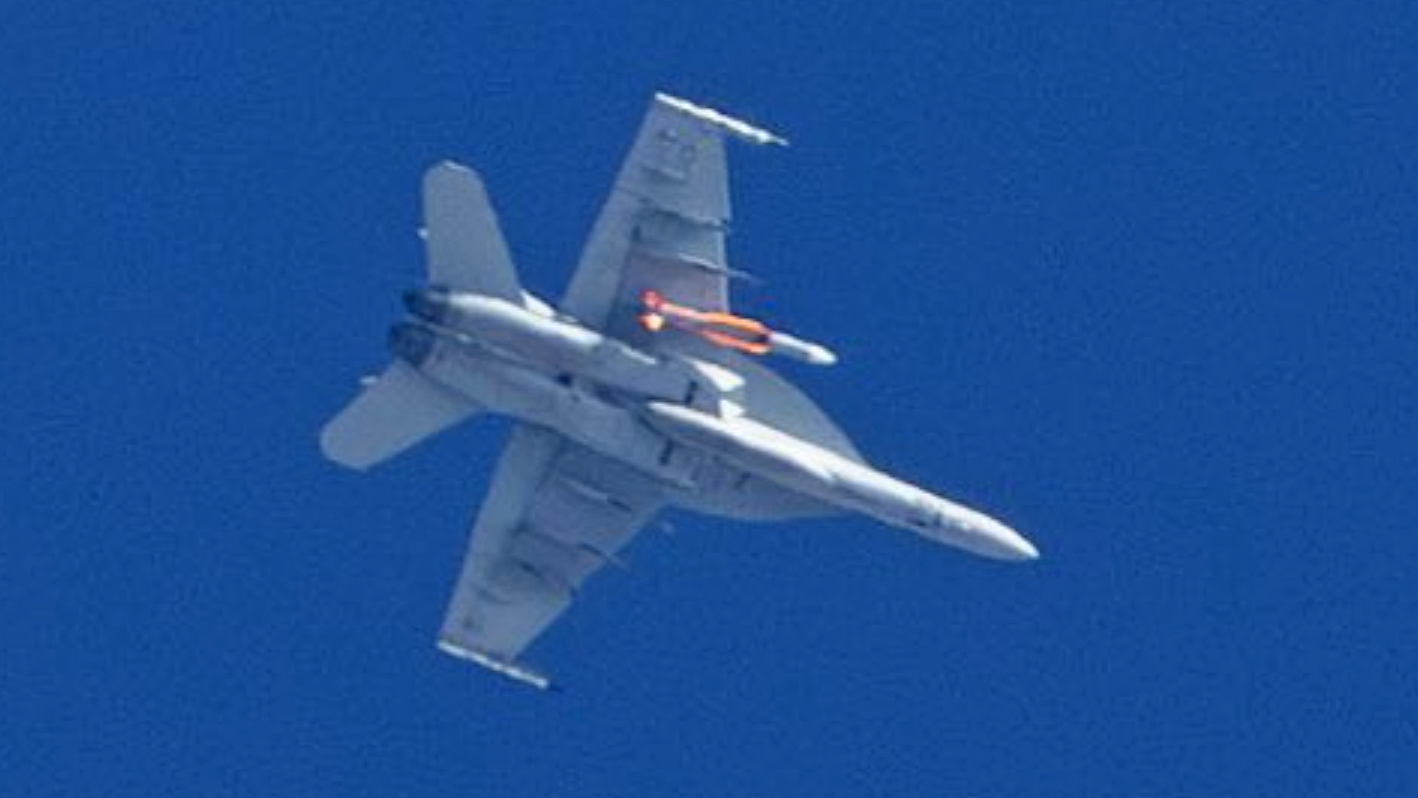Photos have emerged showing a U.S. Navy F/A-18E/F Super Hornet carrying what appears to be an air-launched version of the hugely versatile SM-6 missile, also known as the RIM-174. The SM-6 was originally designed as a surface-launched weapon that can counter air-breathing aerial threats at long ranges, ballistic missiles in their terminal stages of flight, and now even hypersonic weapons under specific circumstances. The SM-6 can also be used to strike high-priority ground targets, such as air defense sites, and warships, acting as a quasi-ballistic missile. The U.S. Army has also adopted it as a ground-launched weapon for use in the land attack role. SM-6 traditionally uses Mk 41 Vertical Launch System architecture for deployment.
The Super Hornet and SM-6 combination was spotted before — three years ago — but has never been officially acknowledged by the Navy. It is possible that what we are seeing is a Super Hornet being used as a launch platform for an SM-6 that’s intended to be used as a surrogate for a test, such as mimicking an air-launched ballistic missile. The missile could also be carried aloft by the fighter for prolonged aerial testing of an onboard system, such as its datalink or active radar seeker. It also may well be the case that the Navy is working to add this powerful capability to the fighter — or possibly already has.
The photos were shared with TWZ by a photographer who uses the handle Stinkjet and whose captures are well worth taking a look at on his Instagram account, which you can find here.



Stinkjet told us that the four photos were taken around 60 miles north of Naval Air Weapons Station China Lake, California, on April 17. “I was photographing other aircraft in the R-2508 and happened to look up and see this ‘Rhino’ with what I thought was an unusually large missile,” they explained. Stinkjet was unsure what the missile was until he posted the photos yesterday.
The photographer is “fairly confident” that the aircraft belongs to Air Test and Evaluation Squadron (VX) 9, based on radio communications heard around the same time, although it could possibly be assigned to VX-31. It was a VX-31 aircraft that was carrying an SM-6 when the missile was first noted aboard a Super Hornet.
“The jet did three orbits above us and then left,” Stinkjet says. “It was taken on my Canon R6 MK2 at 800mm.” The photographer estimates the jet was flying at around 18,000 feet when captured.
If indeed this is an air-launched SM-6, the missile would drastically expand the Super Hornet’s capabilities. When the previous photo of an SM-6-toting F/A-18F came to light, back in 2021, TWZ approached the Navy for more details about this possibility but received no definitive answer. Once again, we have approached the service for comment about these latest photos.
Clearly, however, there has been a significant gap between the first appearance of the Super Hornet/SM-6 combination and this latest one, suggesting that whatever testing is involved has been going on for a while now. In both instances, the missiles also had the same orange-colored fins and strakes.

Whatever the case, integration of the SM-6 on the Super Hornet would offer some very intriguing benefits for the U.S. military as a whole.
Above all, the SM-6 offers a compelling combination of extended range and versatility, as well as being part of a powerful and existing combat communications network.
Its adaptability means it can be used to engage a wide variety of aerial threats — its primary role. This would give the Super Hornet the ability to hit aircraft and missiles drastically farther away — over hundreds of miles — than what it currently is capable of. The forthcoming AIM-260 air-to-air missile should close part of this gap, but it’s doubtful it will approach the reach of an SM-6.
The ability to strike targets on land and at sea, and also do so over great distances, with a hard-to-intercept weapon that travels at near or over hypersonic speed during the terminal stage of its flight, is also unlike anything the F/A-18E/F has in its weapons portfolio today.

The challenges of a future potential conflict with China in the Pacific have seen the Pentagon become more and more concerned with long-range ‘kill chains,’ especially as Beijing pursues increasingly long-legged air-to-air missiles of its own. This is in addition to the anti-access/area-denial capabilities China has invested in heavily that aim, in part, to keep enemies from getting within striking distance of key targets during a conflict.
Launched via booster from a warship, the 3,300-pound SM-6 has an estimated range of around 230 miles, although this figure depends on a wide array of factors, and usually real effective ranges are discounted for public consumption. Regardless, firing an SM-6 from a high-flying and fast-moving fighter would extend this number significantly further. Combined with the fighter’s ability to deploy far forward, with its effective combat range only really limited by proximity to aerial refueling and the enemy’s defenses, air launch could make the SM-6 an effective weapon positioned many hundreds of miles forward in the battlespace from any ship or ground-launcher.
Launched from a warship, an SM-6 intercepts a medium-range ballistic missile target off the coast of Hawaii in August 2017:

While giving Super Hornets the ability to counter aerial threats at very long distances via an off-the-shelf missile would be a big capability boost, the standoff attack capability that the SM-6 could provide the Super Hornet is arguably just as important. Again, with future Pacific contingencies in mind, this could be of huge relevance, both for striking maritime targets and ones on land.
Launching the SM-6 from any kind of platform in an anti-surface warfare role is becoming increasingly critical. Currently, Super Hornets can employ the Harpoon for this mission. Harpoon Block II variants can hit targets at a range of around 75 miles, the SM-6 offers triple the range, and possibly even more. It’s also a much harder weapon to defend against than a subsonic anti-ship cruise missile. Layering in SM-6s with anti-ship cruise missiles would drastically complicate the defense of a targeted vessel or flotilla, increasing the chances of successfully taking it off the board. The fact that aircraft can launch from less predictable vectors compared to warships, makes defending against such an attack even more challenging.

The ability to have Super Hornets extend the defensive (and offensive) umbrella of a naval task force beyond the range offered by the regular, surface-launched SM-6 would be a key advantage. The fact that the SM-6 is already a ‘networked’ weapon, with the ability to receive targeting information from third-party sources, drastically opens up the ways in which it can be used.
A Super Hornet armed with SM-6 would be able to exploit the multiple benefits of the Navy’s still-evolving ‘kill web’ architecture. This is the Naval Integrated Fire Control-Counter Air concept, or NIFC-CA, designed to bring together the complementary attributes of platforms such as the F-35 stealth fighter, E-2D Advanced Hawkeye radar plane, Aegis-equipped warships, and weapons like the SM-6.

NIFC-CA means that high-fidelity targeting data can be shared across disparate warships and aircraft, creating a robust network of sensors and shooters that are better able to defend the carrier strike group, or be used to achieve other key objectives. At the same time, since the SM-6 could outrange the Super Hornet’s own sensors, the use of offboard cueing via NIFC-CA could be the key to exploiting the weapon’s capabilities to the full extent possible.
The use of NIFC-CA targeting, which leverages the whole of a strike group’s sensor capabilities, and even fuzes them with data from space-based assets, could open up the potential for a Super Hornet to engage targets it is not capable of doing on its own. This could include ballistic missiles in their terminal phases of flight or even incoming hypersonic weapons. Similarly, surface targets or even those on land can be sent to the Super Hornet via datalink for SM-6 tasking.
If the Navy is really adapting SM-6 as an air-launched weapon, we could see other services follow suit. USAF fighters, such as the F-15EX, could also host the weapon. Bombers such as the B-52 and B-21 could also leverage its unique attributes, both in an air-to-air and air-to-surface role.
While we don’t know for sure whether SM-6-armed Super Hornets are going to become an operational reality, it seems clear that arming the fighter, and potentially other combat aircraft, with this weapon would make a lot of sense. Whatever the story behind last month’s test out of China Lake, it points to the versatility of the SM-6 and its growing importance to the Pentagon at large.
Contact the author: thomas@thewarzone.com
